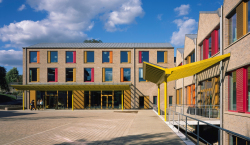Mastering Mass – Jeremy Climas on What Really Helps to Prevent Classrooms From Overheating
14 October 2020

A recently published large-scale article in Concrete Quarterly examines in-depth how exposed structures could play a crucial role in combating overheating in classrooms. Our Jeremy Climas, Head of Education, is prominently featured.
As the planet grows hotter, keeping classroom temperatures within acceptable limits will become harder and harder. A recent performance model of 11 newly designed schools revealed that a large number of classrooms will overheat in the predicted future climate.
A potential low-energy strategy to keep classrooms comfortable is to use the thermal mass of a building – but you have to get it right. Possible solutions are night-purging:
“’In order for a night-purging strategy to be successful, the building’s users have to have absolute confidence in it’, warns Jeremy Climas, head of education at Max Fordham, which has designed a series of high-performing naturally ventilated schools. ‘There are thousands of buildings where, for example, the design team allowed for natural ventilation at night but the people who operate the building don’t use it like that. It’s not enough to design something that you think should work, you have to have client buy-in.’”
... or making the concrete structure as materially efficient and low-carbon as possible, e.g. by using ribbed precast-concrete soffits, as seen at the Sevenoaks School Science & Technology Centre in Kent:
“You don’t need as much of it and it increases the surface area so the thermal mass works even better”
If you’d like to gain further insights, you can read the full article here.

.jpg)